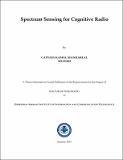Please use this identifier to cite or link to this item:
http://drsr.daiict.ac.in//handle/123456789/792| Title: | Spectrum sensing for cognitive radio |
| Authors: | Joshi, Manjunath V. Manharlal, Captain Kamal |
| Keywords: | Cognitive radio spectrum sensing narrowband spectrum sensing wideband spectrum sensing energy detection generalized energy detection noise uncertainty SNR wall diversity cooperative wideband spectrum sensing hard combining |
| Issue Date: | 2019 |
| Publisher: | Dhirubhai Ambani Institute of Information and Communication Technology |
| Citation: | Manharlal, Captain Kamal (2019). Spectrum Sensing for Cognitive Radio. Dhirubhai Ambani Institute of Information and Communication Technology, xiii, 142 p. (Acc. No: T00757) |
| Abstract: | Due to the rapid growth of new wireless communication services and applications, need for radio frequency (RF) spectrum is continuously increasing. Most of the available RF spectrum is already been licensed to the existing wireless systems. On the other hand, it is found that spectrum is significantly underutilized due to the static frequency allocation to the dedicated users and hence the spectrum holes or spectrum opportunities arise. Considering the scarce RF spectrum, supporting new services and applications is a challenging task that requires innovative technologies capable of providing new ways of exploiting the available radio spectrum. Cognitive Radio (CR) has received immense research attention, both in the academia and industry, as it is considered a promising solution to the problem of spectrum scarcity by introducing the notion of opportunistic spectrum usage. A CR is a device that senses the spectrum of licensed users (also known as primary users) for spectrum opportunities, and transmits its data only when the spectrum is sensed to be not occupied. For the efficient utilization of the spectrum while limiting the interference to the licensed users, the CR should be able to sense the spectrum occupancy quickly as well as accurately. This makes spectrum sensing one of the main functionalities of the cognitive radio. Spectrum sensing is a hypothesis testing problem, where the goal is to test whether the primary user is inactive (the null or noise only hypothesis), or not (the alternate or signal present hypothesis). Spectrum sensing can be broadly classified into two types, namely, narrowband and wideband sensing. Narrowband sensing is used for finding the occupancy status of a single licensed band where as wideband sensing deals with the scenario where multiple licensed bands are sensed for spectrum opportunities. In this thesis, our focus is on the analysis of the existing spectrum sensing algorithm considering practical scenarios and propose novel techniques for spectrum sensing. Energy detection (ED) also known as conventional energy detection (CED) based spectrum sensing is a very popular technique due to its simplicity and reduced computational complexity. In our first work, we analyze the ED based narrowband spectrum sensing over h ?? l ?? m fading channel model. It is a general model and includes other fading models as its special cases and can be used to study the performance of ED under practical scenarios. The performance improvement is shown using antenna diversity and cooperative sensing. The analysis is then extended to the case when there exists shadowing in addition to fading. ED is generalized by changing the squaring operation while computing energy by an arbitrary positive number p which is known as generalized energy detector (GED). To decide the threshold for GED, the true value of the noise variance is required but in practice only its expected value is known. The true value of noise variance varies over time and location giving rise to noise uncertainty. Due to this there exist a phenomenon known as signal to noise radio (SNR) wall which says that in the presence of noise uncertainty below certain SNR value known as the SNR wall, it is not possible to detect the presence of signal even if very large number of samples are taken for detection. In our second work, we study the SNR wall for GED considering no diversity, diversity and cooperative sensing scenarios under noise uncertainty and fading. All the derived expressions are validated using Monte Carlo simulations. In literature, the use of antenna diversity to improve the detection performance of narrowband spectrum sensing is extensively studied. In our next work, we propose new detection algorithms that make use of square law combining (SLC) and square law selection (SLS) diversities for wideband spectrum sensing. We provide complete theoretical analysis of the proposed algorithms and validate them using Monte Carlo simulations. The performance improvement is shown against the algorithm that do not use diversity. We also study the effects of different parameters on the performance of the proposed algorithms. An alternative to antenna diversity is the cooperative spectrum sensing where multiple secondary users also known as cooperating secondary users collaborate by sharing their sensing information for the detection of the spectrum opportunities. Finally, in our last work, we propose novel detection algorithm for cooperative wideband spectrum sensing. We make use of hard combining for data fusion since it minimizes the bandwidth requirements of the control channel. We show that the proposed algorithm performs better than algorithm without cooperative sensing. Also, it performs better than our previously proposed algorithms that use antenna diversity by choosing appropriate number of cooperating secondary users. We also study the effects of different parameters on the performance. |
| URI: | http://drsr.daiict.ac.in//handle/123456789/792 |
| Appears in Collections: | PhD Theses |
Files in This Item:
| File | Description | Size | Format | |
|---|---|---|---|---|
| 201321003_Captain Kamal Manharlal.pdf | 201321003 | 1.28 MB | Adobe PDF |  View/Open |
Items in DSpace are protected by copyright, with all rights reserved, unless otherwise indicated.
